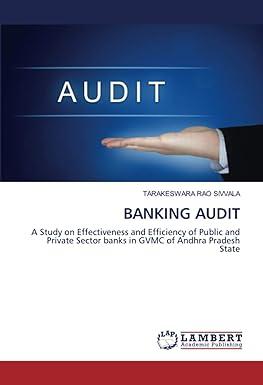Question
QUESTION 1: (20 MARKS) Answer each of the following questions by writing down the correct letter next to relevant the number. Unless otherwise indicated, questions
QUESTION 1: (20 MARKS)
Answer each of the following questions by writing down the correct letter next to relevant the number. Unless otherwise indicated, questions are not related. Only one answer per question will be allowed.
1. A firm decided to provide for a 4% or R160 allowance for credit losses on all outstanding debts (debtors). Which of the following is the value of total outstanding debts of the firm at the time of creating the provision?
- R2 000
- R5 000
- R1 000
- R4 000
- None of the above. (2)
1.2 OLIVE Ltd has a current ratio of 1,6 : 1 and an acid test ratio (quick ratio) of 1,2 : 1. The company has R2 000 000 in sales and its current liabilities are R1 000 000. What is the value of the companys current assets?
- R1 600 000
- R1 200 000
- R3 200 000
- R2 400 000
- None of the above. (2)
1.3 Which of the following is a possible reason for a companys average debtors collection period falling from one year to the next?
- An improvement in the state of the economy.
- A large credit customer facing severe cash shortages.
- Economic recession.
- An extension or increase in the credit terms (days) offered by the company.
- None of the above. (2)
1.4 A company experiences a dramatic fall in its gross profit ratio (%). This could be the result of which of the following?
- An increase in operating expenses.
- A decrease in operating expenses.
- An increase in competition in the companys main product market.
- An increase in the demand for the companys main products.
- None of the above. (2)
1.5 KULPA Ltd has a current ratio of 0,7 : 1. Which of the following transactions would increase (improve) this ratio?
- Paying off long-term debt with cash
- Selling inventory at cost for cash.
- Collecting accounts receivable (debtors) in cash.
- Paying off accounts payable (creditors) with cash.
- Purchasing inventory on credit. (2)
Step by Step Solution
There are 3 Steps involved in it
Step: 1

Get Instant Access to Expert-Tailored Solutions
See step-by-step solutions with expert insights and AI powered tools for academic success
Step: 2

Step: 3

Ace Your Homework with AI
Get the answers you need in no time with our AI-driven, step-by-step assistance
Get Started


